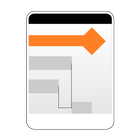Haolingxiazai provides the latest software downloads for Gantt Chart games.


Gantt Chart
| App Name | Gantt Chart |
|---|---|
| Genre | Productivity |
| Size | 9.8 MB |
| Latest Version | 10.5 |
| MOD Info | Premium Unlocked |
| Get it On |

|
Gantt chart for your project management.
Create gantt chart(WBS) quickly for your project management.
It is helpful through planning to operation as ToDo list and Memo pad are attached.
Function:
- Create gantt chart with tasks, sub tasks and milestones.
- Draw links which shows the dependency between tasks.
- View the summary table for tasks and links.
- Project files can be shared on the cloud.
- Memo pad and Todo list.
- Create PDF file
Project View:
- Top page of this app.
- Open task view by tapping the project.
- Open editing menu by long tapping the project.
- Plus button shows the dialog to create new project.
- Cloud button shows the menus for sharing the project on the cloud.
- Timer button shows the dialog to set the push notification.
Task View:
- List the tasks.
- Task type is task, sub-task or milestone.
- Open task editor by tapping the task.
- Tasks can be filtered by date, progress and person.
- Auto Sync of the progress is available.
- Save button allows for save, save-as or upload to the cloud.
- Arrow button shows the gantt chart.
Link View:
- List the links.
- Invalid link is shown in red color.
- Open link editor by tapping the link.
Todo View:
- List the Todo.
- Open the editor by tapping the item.
- Switch the status by tapping the check mark.
Gantt Chart:
- Move by swiping.
- Zoom in/out button.
- Sub tasks can be fold by tapping the plus mark at left side of the task.
- Task editor opens by tapping the chart.
- Link editor opens by long tapping the chart.
Cloud Service:
- You can share the project with the other users on the cloud.
- Registration is required to accessing the cloud.
Note:
- No advertisement if you pay for the Premium item.
- This app uses the Apache 2.0 license library - AChartEngine.
(http://www.apache.org/licenses/LICENSE-2.0)
What's New in the Latest Version 10.5
Last updated on Jul 15, 2024
(2024.7.14)
- API maintenance
(2023.12.16)
- library update.
The foundation of a Gantt chart is a timeline, forming the horizontal axis. This timeline represents the project duration, broken down into increments like days, weeks, or months. Tasks are listed vertically, creating a clear visual connection between each activity and its corresponding timeframe. Each task is represented by a horizontal bar, the length of which corresponds to its estimated duration. The position of the bar on the timeline indicates the task's scheduled start and end dates.
A key strength of Gantt charts lies in their ability to visualize dependencies between tasks. Dependencies, or relationships between activities, dictate the order in which tasks must be completed. For instance, some tasks cannot begin until others are finished. Gantt charts depict these dependencies through connecting lines or arrows between task bars, visually illustrating the workflow and highlighting critical paths.
The critical path, a crucial concept in project management, represents the sequence of tasks that determine the shortest possible project duration. Any delay in a task on the critical path will directly impact the overall project completion date. Gantt charts effectively highlight the critical path, allowing project managers to prioritize these crucial activities and allocate resources accordingly.
Beyond scheduling, Gantt charts facilitate resource allocation. By visualizing task durations and dependencies, managers can identify potential resource conflicts and adjust assignments to optimize utilization. This prevents overallocation or underutilization of resources, ensuring smooth project execution.
Progress tracking is another significant advantage of Gantt charts. As tasks are completed, the corresponding bars on the chart can be shaded or filled, providing a visual representation of progress against the planned schedule. This allows for easy monitoring of project status and early identification of potential delays.
Gantt charts are versatile tools, applicable to various project sizes and complexities. From simple projects with a few tasks to complex endeavors with numerous interconnected activities, Gantt charts provide a clear and concise overview of the project schedule. They are particularly valuable in projects involving multiple teams or stakeholders, facilitating communication and ensuring everyone is aligned on the project timeline.
Different types of Gantt charts cater to specific needs. Basic Gantt charts focus on task scheduling and durations. More advanced versions incorporate features like resource allocation, cost tracking, and baseline comparisons. Modern software applications offer interactive Gantt charts, allowing users to dynamically update tasks, dependencies, and progress in real-time.
While traditional Gantt charts were primarily static documents, modern software solutions offer dynamic and interactive capabilities. These interactive Gantt charts allow for real-time updates, enabling project managers to adjust schedules, allocate resources, and track progress dynamically as the project evolves. This flexibility is crucial in adapting to unforeseen changes and ensuring project success.
The use of Gantt charts extends across various industries and project types. From construction and manufacturing to software development and marketing campaigns, Gantt charts provide a valuable framework for planning, scheduling, and managing projects effectively. Their visual nature makes them easily understandable and accessible to all stakeholders, fostering collaboration and transparency.
In conclusion, Gantt charts are powerful visual tools that play a vital role in effective project management. By providing a clear and concise representation of project schedules, dependencies, and progress, they empower project managers to plan, execute, and monitor projects efficiently, ensuring successful outcomes. Their versatility and adaptability make them an indispensable asset in various industries and project environments, contributing to improved project planning, execution, and overall success.











